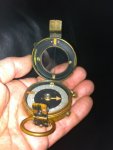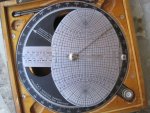maxingout
Adventurer
Thanks to everyone for the great info. I came across this sun compass/clock application a while back and am intrigued to try it someday. It creates a sun compass for a particular date and latitude. You print it out and set it up with your own pointer. Once set up correctly it is apparently very accurate to steer by in a vehicle. No problems with magnetic deviation. On the site there is a guy from Australia who actually used this to navigate a section of the outback.
David
http://chrismolloy.com/sunclock
I had an old Davis Pelorus with a rotating azimuth card on it, and it made a great sun compass. The problem was that it was plastic, and I eventually broke it when I was sailing offshore around the world. There was a center pin that cast a shadow on the azimuth card, and you rotated the azimuth card to the true bearing of the sun for that time of day at your assumed latitude and longitude. Once the azimuth card was oriented to the sun, you could use the two plastic sighting vanes to get true direction rather than magnetic direction. It was magic once the azimuth card was properly oriented. Unfortunately, you have to keep moving the azimuth card as the sun changes in position in the sky. It's a little tedious but it does work very well. Taking bearings on the sun with a pelorus is one of the classic ways that compass adjusters used to make their living.
A sun compass isn't rocket science, but it is a bit of a hassle because the sun is moving in the sky, and you are moving on the earth's surface as you navigate. So you have to take that into consideration as you take your bearings and run your courses. It isn't GPS, but a great deal of big time navigation has been done only with a sun compass and celestial sights. Nearly a hundred years ago Bagnold and the Long Range Desert Group in the Libyan and Egyptian deserts were masters of the sun compass, and it worked well for them
Last edited:




